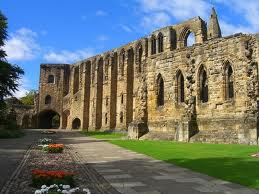November 16th is, in the modern calendar, the Feast of St Margaret of Scotland. Another occasion to talk about Scottish pre-reformation church buildings, as well as the Saint of the day. In a recent post, we talked about Pluscarden Abbey, Dunblane Cathedral and Dunkeld Cathedral, this time the focus must be on Dunfermline Abbey.
Born in Hungary around 1045, granddaughter of the exiled King of England, Margaret grew up in the pious atmosphere of the Hungarian Royal Court of "King Andrew the Catholic". Her family returned to England for a few years, and then fled north to Northumbria after the Norman invasion. Legend has it that the family was attempting to return to Europe when a storm blew their boat north and brought them to land in what is now the town of North Queensferry (a place I remember well from my childhood). A few years later, Margaret married King Malcolm III of Scotland and became one of the most well known of those who have held the title Queen of Scots.
She is remarkable for several reasons. First as a mother of eight children : three of her sons became Kings of Scotland, one of her daughters married King Henry I of England, another married the Count of Boulogne (the elder brother of King Baldwin I of Jerusalem), and yet another son became Abbot of Dunkeld. She is also well known for her works of charity, indeed the towns of North and South Queensferry are so named because she provided for there to be ferry services there for pilgrims to cross the River Forth from Edinburgh to St Andrews in Fife. Another reason for her influence being so strong is that, like St Cedd, St Wilfred and St Hilda, she was a key mover in ensuring that the practices of the local church conformed to the practices of the Church as a whole.
In 1072, King Malcolm and Queen Margaret invited the Benedictines to send some of their number from Canterbury to turn Dunfermline Abbey (which had started life in the ninth century) into a Benedictine Priory Church. The Abbey was properly founded, with Geoffrey of Canterbury as its first Abbot, in the reign of King David I (not, as was subsequently claimed for the purposes of increasing the cult of St Margaret, under King Malcolm and Queen Margaret).
Dunfermline Abbey itself holds a remarkable place in Scottish religious history. Turned over to the crown after the Reformation, during which it was sacked, the Abbey was caught up in the Episcopalian vs Presbyterian difficulties of the 17th century, at one time having both an Episcopalian Bishop and a Presbyterian minister running parts of the building. At the time of the early 19th century splits in the Church of Scotland, its minister first decided to join the Free Church of Scotland, then returned to the Church of Scotland.
The Abbey is also a potent symbol of Scottish nationhood, not only on account of its royal foundation by Malcolm and Margaret. Legend says that the mother of William Wallace is buried there, and it is known that King Robert the Bruce is buried there (Dunfermline became the burial place of Scottish kings after the Norwegian occupation of Iona, and has received more Scottish royal dead than any other place other than Iona). The Bruce's remains were exhumed in the early 19th century, when extensive reconstruction work was needed following the collapse of the Abbey's tower, and he was subsequently reburied in the fervent atmosphere of 19th century romanticist Scottish fantasy (it's OK, I can say that, I'm Scottish....).
The tomb of St Margaret herself, within the ruins of the Lady Chapel, was restored and enclosed on the orders of Queen Victoria.
More recently, the Abbey has shown itself to be very open to recognising its complicated but stunning religious history, and in 2005 invited Cardinal Keith O'Brien, the Archbishop of St Andrews and Edinburgh, to preach, the first Catholic to preach in Dunfermline Abbey since the Reformation. That same day, the Lord Lyon King of Arms formally presented new armorial bearings to the Abbey in the person of its minister. The Lord Lieutenant of Fife and the Earl and Countess of Elgin were in attendance.
In order to provide some relevant music, I tried to find a youtube link to some Robert Carver, a Scottish renaissance composer of some rather good polyphony, but could find none. I recommend the recordings made by Andrew Carwood of Carver's works. Instead, maintaining the theme of the Scottish hierarchy, here is a video of Cardinal O'Brien assisting at an FSSP Solemn High Mass in St Mary's Catholic Cathedral in Edinburgh.
St Margaret of Scotland, pray for us.








No comments:
Post a Comment